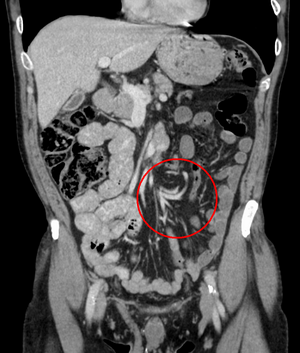Midgut volvulus
| Volvulus | |
|---|---|
 |
|
| Coronal CT of the abdomen, demonstrating a volvulus as indicated by twisting of the bowel stock | |
| Specialty | General surgery |
| Symptoms | Abdominal pain, abdominal bloating, vomiting, constipation, bloody stool |
| Complications | Ischemic bowel |
| Usual onset | Rapid or more gradual |
| Risk factors | Intestinal malrotation, enlarged colon, Hirschsprung disease, pregnancy, abdominal adhesions, chronic constipation |
| Diagnostic method | Medical imaging (plain X-rays, GI series, CT scan) |
| Treatment | Sigmoidoscopy, barium enema, bowel resection |
| Frequency | 2.5 per 100,000 per year |
| Classification | |
|---|---|
| External resources |
A volvulus is when a loop of intestine twists around itself and the mesentery that supports it, resulting in a bowel obstruction. Symptoms include abdominal pain, abdominal bloating, vomiting, constipation, and bloody stool. Onset of symptoms may be rapid or more gradual. The mesentery may become so tightly twisted that blood flow to part of the intestine is cut off, resulting in ischemic bowel. In this situation there may be fever or significant pain when the abdomen is touched.
Risk factors include a birth defect known as intestinal malrotation, an enlarged colon, Hirschsprung disease, pregnancy, and abdominal adhesions. Long term constipation and a high fiber diet may also increase the risk. The most commonly affected part of the intestines in adults is the sigmoid colon with the cecum being second most affected. In children the small intestine is more often involved. The stomach can also be affected. Diagnosis is typically with medical imaging such as plain X-rays, a GI series, or CT scan.
...
Wikipedia
